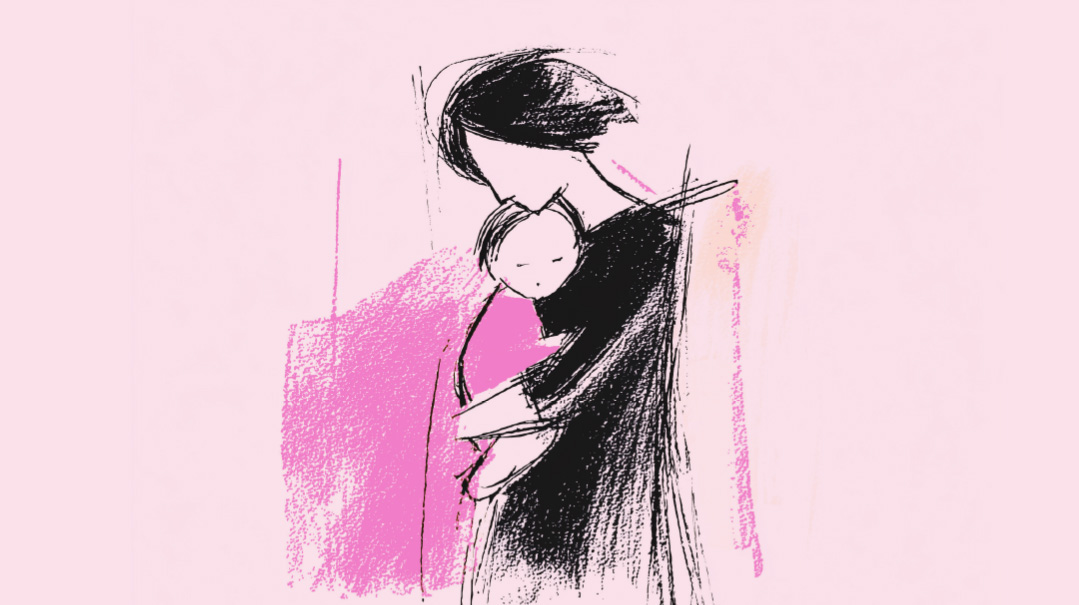The Thousand-Mile Shidduch


How close are Ethiopia and England? When Ethiopian Galit married British Eliyahu, they found that with rock-solid emunah and a generous dash of flexibility, the bridging of two very different cultures could become the adventure of a lifetime
“Life in a village in the mountains of north Ethiopia was only a little different from the kind of life that Avraham Avinu led,” Galit says from her apartment in Ramat Beit Shemesh. With gentle candor, she takes me back to her home, and the rock-solid faith she imbibed as a child. It was this emunah temimah that her husband was drawn to.
The simple homes in Avratensa, a tiny village near the city of Gonder, northwest Ethiopia, were set among hills of tawny grass dotted with tall trees. The round huts were constructed from a framework of branches, plastered with gray-green clay that the women prepared, and topped with a roof of straw. Beds lined the walls, with parents sleeping on the top bunks.
Men worked in fields an hour’s walk away, cultivating wheat, barley, and corn. Closer to home, the women tended vegetable patches filled with peas, beans, and pumpkins. “We also grew cotton, and my mother would roll it into threads that she’d weave on a simple wooden loom into cloth, which we then dyed and embroidered,” Galit recalls. “An industrious housewife would be up at five in the morning to join the group of women going to the river to fetch water in clay jugs that we had made.”
Jewish life in this simple setting was rich. “My father prayed to Hashem in his own words every morning, before leaving for the wheat fields. My mother was always talking to Hashem. When it rained, she’d pray for the rain to fall as a blessing and not a curse. When my three brothers, sister, and I left our home to walk to the village school, she’d ask Hashem to open our hearts to learn good things,” says Galit. “On Shabbat, however, we all went to shul and repeated set prayers after the kesim (rabbis). Then we’d make Kiddush over bread — we didn’t grow grapes. Back at home, we ate a cold milchig meal, because we couldn’t light a fire on Shabbos.”
Many of the hundred people in Galit’s village descended from the elder who headed the village. “We took a fiery pride in our status as Jews and could all draw our lineage back seven generations,” says Galit. “We kept ourselves totally separate from the non-Jews, refusing to attend their schools. I’d never seen a non-Jew before I left the village when I was six years old. When my husband later told me that he had been to school with non-Jews, I was horrified. In Ethiopia, if a non-Jew touched you, you had to toivel. The non-Jews in turn, looked at us with awe.”
This respect from non-Jews was so second nature to Galit that when she visited London after her marriage and heard Muslims hurl racist comments at her family as they walked back from shul on Shabbos morning, she yelled back just as loudly, much to the consternation of her new English family.
The Exodus
“Jerusalem was a dream that never left our consciousness,” says Galit, who was known as Agritu (Amharic for aretz), a name that reflected the longing for Eretz Yisrael that pulsed through the blood of Beta Jews. “If I fell, my mother would tell me that in Jerusalem I wouldn’t feel any pain. On the rare occasions that we sucked on a sugar cube bought in the market near Gonder, we’d be reminded that in Jerusalem, sweets would taste even better.”
The longing to return to Jerusalem reached a peak on Pesach. “Erev Pesach, the children were urged to eat up all the chometz, the words ‘Blu, blu, eat, eat,’ still resound in my mind,” says Galit. “We sat quietly at the Seder, satiated because we’d eaten all the chometz, our staffs and matzah in our hands, wearing new clothes and waiting for the magical moment when we’d leave Ethiopia just as our ancestors had left Egypt. When we did finally leave, it was as natural as acting out Seder night.”
In 1984, rumors spread that Jews could reach Israel via Sudan. Quietly preparing to leave, the villagers sold their goats to buy horses and donkeys for the long trek and packed provisions.
“Most of the village left on a single night,” Galit says, her eyes shining with the same excitement that she must have felt as a seven-year-old child. “I remember looking at the moon and thinking that after generations of talking about it, I was finally going to Israel.”
Led by a smuggler who was liable to turn on them at any moment and aware of the real danger of being caught, Galit’s village left on a three-week trek that was fraught with fear. “At one point, we had to cross through private property,” Galit recalls. “The furious landowner took out his gun, shot in the air, and threatened to report that we were fleeing.”
The villagers had packed dry crackers, flour, and beans for the trek. “We would bake pita whenever we stopped for a rest, but when I fell ill, I couldn’t swallow the dry food,” says Galit. “The smuggler leading us begged for some injera [a large, sourdough, blintz-like bread made from fermented teff flour] in a village we passed. My mother moistened the injera with water and I was fed like a little chick.”
The group swelled along the way as other villages joined them. As they approached the Sudanese border, the smuggler abandoned his charges, leaving them to deal with rogues who appeared in noisy, smelly trucks the likes of which the villagers had never seen before.
“For a price, they offered to drive us to refugee camps,” recalls Galit. “People who were penniless begged money from those who had. It was my first experience in a vehicle. The noise was terrible, the smell of petrol nauseating.”
The following year, spent in a refugee camp, was no less challenging than the trek itself. “We weren’t used to the food we were given and some of us died from the change in diet. Luckily, my mother got a job housecleaning close to the camp, so she was able to bring us the beans and vegetables we were used to.”
Here too, the pall of disease spread its cloud. “Both my brother and I became ill with malaria. My nephew and a cousin with whom I’d shared my horse while fleeing also caught malaria and died,” says Galit, the pain of the loss still sharp.
Sadly, thousands of refugees perished while fleeing and in the camps. “Death became such a part of life that we got used to something abnormal and lost some of our sensitivity,” says Galit.
Finally, in 1991, Operation Moses got under way and Galit’s family left for Israel at last.
Turning White
Arriving in Israel, Galit immediately noticed that everyone was white — so she waited to turn white too. “I was disappointed when it didn’t happen,” she remembers.
Galit points out that the children had to cope with the adaptation process alone. “We couldn’t rely on our parents to rally for us because they, too, were out of their depth. Even turning to older siblings for help was out of the question, because everyone was struggling with his own issues.
“Of course I felt abandoned. Learning to manage on my own and never having someone to turn to for help was hard. Luckily, I was tremendously curious and ready to learn everything that I needed to know to adapt to the new culture,” she says, displaying the grit that kept her moving forward. Then Galit laughs and shares an anecdote: “My mother and I went to parent-teacher meetings together. The teacher would tell me what to tell my mother about myself!”
Sadly, the Beta Israel community received a lukewarm welcome to Israel. “We were used to seeing ourselves as the elite and were proud to trace our lineage,” says Galit. “Suddenly people who didn’t even dress like Jews were questioning our identity. We were confused, angry, and terribly hurt. We fell from the peak of a mountain into a dirty puddle. The sting is still there. It’s something that the Ethiopian community is still struggling with today.”
At the same time, the Ethiopian Jews were elated to learn more about serving Hashem. “We were eager to learn about set prayers and brachot because we felt we were being taught how to praise Hashem more fully and in the language that He had chosen.”
However badly Galit wanted to belong, the children in her school wouldn’t let her forget she was different. The family lived in an absorption center in Mevasseret Zion on the outskirts of Jerusalem for six years before moving to Ashkelon. In this time, Galit changed schools several times, trying to find a place where she would be accepted. Finally, in sixth grade, she moved to a dormitory in a youth village in Hadera. There, most of the children were also Ethiopian, so socially the tension eased off.
Three years later, Galit joined a high school on a religious kibbutz. “Luckily, one of the teachers fanned the embers that were glowing within me and made me reconnect to the emunah of my childhood,” Galit says. For post-high school studies, Galit bucked the trend set by her classmates and enrolled in Midreshet Shuva on Ofra, a yishuv in the Shomron affiliated with the religious Zionist movement.
“I had grown up believing that everything would be perfect in Israel,” says Galit. “When I came here, my dream was dashed. I had to find my role in this new reality. In Midreshet Shuva we learned about the importance of Eretz Yisrael. This spoke to me because of all that I had learned in my childhood. I learned about chassidut too. The biggest influence was seeing women who kept the mitzvos living with vitality and happiness. Finally I began to envision my role in life.”
A Meeting of Two Cultures
“A strong love for Israel runs in Eliyahu’s family,” says Galit. Rabbi Judah Rockman, Eliyahu’s maternal grandfather, rav of Catford in southeast London, spoke so warmly of Israel that his daughter, Eliyahu’s mother, was inspired to come to Israel a mere week after the Six Day War to volunteer on a kibbutz. Eliyahu’s father shares similar sentiments: decades earlier, he blew the shofar at the Kosel, despite British policy severely limiting Jewish presence at the site. So when Eliyahu Levine left England to volunteer with an Ethiopian community living in caravans in the Carmel Mountains, he was following a family tradition of sorts.
“My husband decided that he wanted an Ethiopian wife after seeing the gentleness, emunah temimah, and natural closeness to Hashem that characterizes authentic Ethiopians,” says Galit.
One evening, as he was strumming his guitar in the Old City, Eliyahu overheard Galit talking with her friends and was impressed.
“The next day, he called Rabbanit Rivka Shapira, the principal of Midreshet Shuva,” says Galit. “It wasn’t difficult for him to describe me — I was the only Ethiopian in the group.”
Rabbanit Shapira encouraged Galit to move forward. “I was always eager to adapt more completely to white culture, so meeting Eliyahu was an attractive next step,” says Galit.
That initial meeting soon led to the chuppah.
“There was never any question about accepting Galit,” says Susan Reuben, Eliyahu’s sister. “Our family is pretty international. My uncle is married to a Yemenite, my sister to a Frenchman, and my own husband’s parents are originally from Iraq.”
When Susan, today a successful shadchan in Ramat Beit Shemesh, says, “You can never tell who Hashem will bring together,” she speaks from firsthand experience.
Galit’s father, however, was against the marriage from the start. “He’s a farangi, stranger,” he declared. “I don’t even know who his grandfather is.”
Galit, who knew that the differences were too big to explain away, simply accepted his anger and moved ahead. Although Galit’s father wasn’t present at the wedding, it only took the birth of their first child to win him over.
“Today when my father calls, the first thing he does is ask after Eliyahu,” Galit says with a laugh.
The Learning Curve
From the start Galit and Eliyahu navigated the gap between their cultures with efficacy.
“In Avratensa, once a woman married, she moved to her husband’s village, the closest of which was a short five-hour walk away, so the idea that a woman should adapt to her husband wasn’t new to me,” Galit says. “In addition, I wanted to belong to this new society, so although my mother warned me that it would be hard, since I had already adapted to Israeli culture, I was confident that I could also learn to be the wife of an Englishman. But more importantly, we were both striving to find a path of truth, and that common bond overrode the differences between us.”
English punctuality was the first thing Galit had to learn. “Time for Ethiopians is very flexible. Even though we had plenty of work, there was never a sense of urgency. Three times a day, we’d hold a coffee drinking ceremony with plenty of relatives that would last about an hour and a half.” Changing her attitude to time took some time.
“If Eliyahu and I arranged to meet in Jerusalem at four o’clock, I’d find myself leaving my parents’ home in Ashkelon at four and I’d be two hours late,” recalls Galit. “Eliyahu would just smile and ask what time I’d left home.”
Eliyahu, for his part, had to learn that if a simchah in his wife’s family was called for a certain time, he’d better learn to rely on her judgment if he didn’t want to be the only one there.
Compromise went hand in hand with the wedding arrangements.
“The wedding wasn’t as organized as an English wedding would have been, but it was full of simchah,” recalls Galit.
Whereas in Ethiopia sheva brachos celebrations would have lasted for a full week with guests coming and going for the entire period as they arrived from neighboring villages, Galit’s parents were satisfied to simply host a flow of guests throughout Shabbos.
“My parents ordered an entire cow to feed the guests,” says Galit with a fond smile.
As to hosting guests in their own home, the Levines have found that Western convention wins out. “In Ethiopia guests can drop in without notice. My parents learned that visits can no longer be spontaneous. And they’ve come to accept that I’ll tell them when we’re planning to visit.”
When Galit gave birth to her first child, cultural differences once again came to the fore. In Ethiopia, mothers retire to a communal home to recuperate immediately after giving birth and remain there for 40 days if they had a boy and 80 days if they had a girl. In the interim, relatives take care of the temporarily motherless families.
“Both my mother and mother-in-law came to help after my first birth” Galit says. “My mother insisted that I remain in my room with the baby and brought me all my meals. Although my mother-in-law couldn’t understand why I wasn’t showing off the baby to our visitors, she too began to bring meals to my room.”
Ethiopian culture is governed by strict hierarchy. “We had naturally and happily submitted to authority because we accepted that our elders knew more than us,” says Galit, describing the social structure in Ethiopia. “We’d never look into the eyes of an older person and we’d only speak when spoken to. If I met a friend who was older than me, I’d wait for her to greet me with a kiss before I could kiss her.”
Assumedly, this ability to offer respect and honor would impact very positively on a marriage. Galit smiles at the suggestion.
“I fully adapted to Western culture,” she says, “but my mother certainly makes up for me in the way she honors my husband!”
Sixteen years of marriage have given the Levines more opportunities than the average couple to find the happy medium. And practice makes perfect: “Since we anticipate differences between us, we’re prepared to work toward an understanding,” says Galit. “This attitude of give-and-take very naturally spills over into areas that aren’t connected to our cultural differences.”
Coming Full Circle
“Part of my drive to fit into Israeli culture was to make sure that my children wouldn’t suffer like I did,” says Galit with her trademark candor. “Well, it didn’t work. My son still asks me not to attend school meetings so that no one will discover he’s got an Ethiopian mother.”
Galit, however, has come full circle. Three years ago, after attending a seminar by Rav Erez Moshe Doron of Lev Hadvarim, Galit internalized some of the teachings of Rebbe Nachman.
“Rav Doron taught that every person has his unique role to play,” she says thoughtfully. “He must become an eved Hashem by playing out the story of his life within his particular circumstances. Today, I help to bridge two worlds so that we can learn from each other: I allay the suspicions that many Ethiopians feel toward white people after the treatment that they’ve endured, and I show white people what they can learn from Ethiopians.”
Then she smiles. “It didn’t take long for my husband to realize how much I’d adapted to Israeli society,” she says. “But since he’d been looking for an authentic Ethiopian wife, he began to steer me back to my roots and make me feel proud of my heritage.”
It may have begun with a culinary propensity for spicy Ethiopian foods and injera, but the emunah temimah that the Levines give over to their children is a purely spiritual legacy.
(Originally featured in Family First, Issue 381)
Oops! We could not locate your form.







